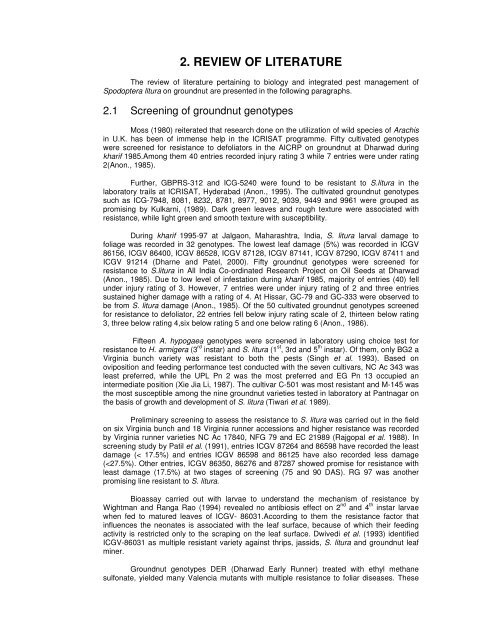screening elite genotypes and ipm of defoliators in groundnut
screening elite genotypes and ipm of defoliators in groundnut
screening elite genotypes and ipm of defoliators in groundnut
Create successful ePaper yourself
Turn your PDF publications into a flip-book with our unique Google optimized e-Paper software.
2. REVIEW OF LITERATURE<br />
The review <strong>of</strong> literature perta<strong>in</strong><strong>in</strong>g to biology <strong>and</strong> <strong>in</strong>tegrated pest management <strong>of</strong><br />
Spodoptera litura on <strong>groundnut</strong> are presented <strong>in</strong> the follow<strong>in</strong>g paragraphs.<br />
2.1 Screen<strong>in</strong>g <strong>of</strong> <strong>groundnut</strong> <strong>genotypes</strong><br />
Moss (1980) reiterated that research done on the utilization <strong>of</strong> wild species <strong>of</strong> Arachis<br />
<strong>in</strong> U.K. has been <strong>of</strong> immense help <strong>in</strong> the ICRISAT programme. Fifty cultivated <strong>genotypes</strong><br />
were screened for resistance to <strong>defoliators</strong> <strong>in</strong> the AICRP on <strong>groundnut</strong> at Dharwad dur<strong>in</strong>g<br />
kharif 1985.Among them 40 entries recorded <strong>in</strong>jury rat<strong>in</strong>g 3 while 7 entries were under rat<strong>in</strong>g<br />
2(Anon., 1985).<br />
Further, GBPRS-312 <strong>and</strong> ICG-5240 were found to be resistant to S.litura <strong>in</strong> the<br />
laboratory trails at ICRISAT, Hyderabad (Anon., 1995). The cultivated <strong>groundnut</strong> <strong>genotypes</strong><br />
such as ICG-7948, 8081, 8232, 8781, 8977, 9012, 9039, 9449 <strong>and</strong> 9961 were grouped as<br />
promis<strong>in</strong>g by Kulkarni, (1989). Dark green leaves <strong>and</strong> rough texture were associated with<br />
resistance, while light green <strong>and</strong> smooth texture with susceptibility.<br />
Dur<strong>in</strong>g kharif 1995-97 at Jalgaon, Maharashtra, India, S. litura larval damage to<br />
foliage was recorded <strong>in</strong> 32 <strong>genotypes</strong>. The lowest leaf damage (5%) was recorded <strong>in</strong> ICGV<br />
86156, ICGV 86400, ICGV 86528, ICGV 87128, ICGV 87141, ICGV 87290, ICGV 87411 <strong>and</strong><br />
ICGV 91214 (Dharne <strong>and</strong> Patel, 2000). Fifty <strong>groundnut</strong> <strong>genotypes</strong> were screened for<br />
resistance to S.litura <strong>in</strong> All India Co-ord<strong>in</strong>ated Research Project on Oil Seeds at Dharwad<br />
(Anon., 1985). Due to low level <strong>of</strong> <strong>in</strong>festation dur<strong>in</strong>g kharif 1985, majority <strong>of</strong> entries (40) fell<br />
under <strong>in</strong>jury rat<strong>in</strong>g <strong>of</strong> 3. However, 7 entries were under <strong>in</strong>jury rat<strong>in</strong>g <strong>of</strong> 2 <strong>and</strong> three entries<br />
susta<strong>in</strong>ed higher damage with a rat<strong>in</strong>g <strong>of</strong> 4. At Hissar, GC-79 <strong>and</strong> GC-333 were observed to<br />
be from S. litura damage (Anon., 1985). Of the 50 cultivated <strong>groundnut</strong> <strong>genotypes</strong> screened<br />
for resistance to defoliator, 22 entries fell below <strong>in</strong>jury rat<strong>in</strong>g scale <strong>of</strong> 2, thirteen below rat<strong>in</strong>g<br />
3, three below rat<strong>in</strong>g 4,six below rat<strong>in</strong>g 5 <strong>and</strong> one below rat<strong>in</strong>g 6 (Anon., 1986).<br />
Fifteen A. hypogaea <strong>genotypes</strong> were screened <strong>in</strong> laboratory us<strong>in</strong>g choice test for<br />
resistance to H. armigera (3 rd <strong>in</strong>star) <strong>and</strong> S. litura (1 st , 3rd <strong>and</strong> 5 th <strong>in</strong>star). Of them, only BG2 a<br />
Virg<strong>in</strong>ia bunch variety was resistant to both the pests (S<strong>in</strong>gh et al. 1993). Based on<br />
oviposition <strong>and</strong> feed<strong>in</strong>g performance test conducted with the seven cultivars, NC Ac 343 was<br />
least preferred, while the UPL Pn 2 was the most preferred <strong>and</strong> EG Pn 13 occupied an<br />
<strong>in</strong>termediate position (Xie Jia Li, 1987). The cultivar C-501 was most resistant <strong>and</strong> M-145 was<br />
the most susceptible among the n<strong>in</strong>e <strong>groundnut</strong> varieties tested <strong>in</strong> laboratory at Pantnagar on<br />
the basis <strong>of</strong> growth <strong>and</strong> development <strong>of</strong> S. litura (Tiwari et al. 1989).<br />
Prelim<strong>in</strong>ary <strong>screen<strong>in</strong>g</strong> to assess the resistance to S. litura was carried out <strong>in</strong> the field<br />
on six Virg<strong>in</strong>ia bunch <strong>and</strong> 18 Virg<strong>in</strong>ia runner accessions <strong>and</strong> higher resistance was recorded<br />
by Virg<strong>in</strong>ia runner varieties NC Ac 17840, NFG 79 <strong>and</strong> EC 21989 (Rajgopal et al. 1988). In<br />
<strong>screen<strong>in</strong>g</strong> study by Patil et al. (1991), entries ICGV 87264 <strong>and</strong> 86598 have recorded the least<br />
damage (< 17.5%) <strong>and</strong> entries ICGV 86598 <strong>and</strong> 86125 have also recorded less damage<br />
(
















